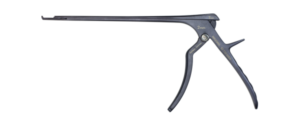Kerrison Rongeurs are essential for spine surgery, and they are a great instrument for decompressing the spine. Most surgeons use an 8” length Kerrison Rongeur, for lumbar cases. Kerrison Rongeurs widths range from 1-6mm while cervical cases use 1-4mm. These can come with or without an ejector, various lengths, widths, and footplates to accommodate approaches as well as patient anatomy.
Kerrison Rongeur Styles
The Kerrison Rongeur is a surgical device composed of a cutting shaft, handle, and footplate. It operates with an external spring that controls the strength and function of the instrument. Depending on the type of procedure, surgeons use different types of footplates: thin or ultra-thin footplates for neck cases, or thin or standard footplates for lumbar and thoracic cases. To make it more efficient in certain situations, some surgeons employ techniques where they use make a ‘backwards bite.’ Unfortunately, this can present issues such as pain and long-term damages caused by the horn digging into the surgeon’s palm. As an alternative to this technique, surgeons can utilize backbiting Kerrison’s and ones that rotate, which help to prevent these unfortunate scenarios.

The down biting kerrison is an essential instrument for surgical procedures, with a design that allows for optimal maneuverability. By inverting the cutting edge and footplate 180°, the back biting kerrison can help surgeons get to certain anatomy in the patient without having to change positions or angle relative to them. Not only is this tool useful in its versatility, but it also helps protect against carpal tunnel syndrome, as the spine of the back biting kerrison does not dig into the palm like other devices do. Additionally, back biting kerrison come in either a standard 40° cutting edge or 90°cutting edge; depending on their preference, surgeons may choose between these two according to their individual needs.
